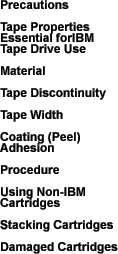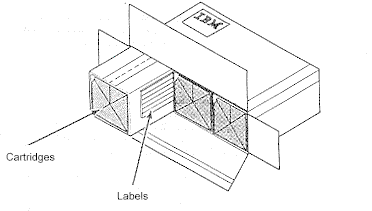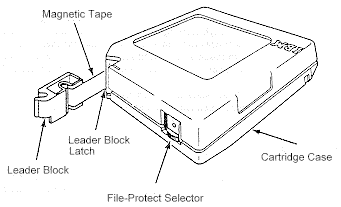Athana
International Every carton of cartridges shipped from IBM contains 30 cartridges and 60 labels: 30 customer labels and 30 volume/serial number labels. Each row of 10 cartridges, within the carton, is sealed in plastic to protect the cartridges from contamination during shipment (see Figure 2).
Incorrect handling or an incorrect environment can damage the magnetic tape or the cartridges. See "Damaged Cartridges" on page 6 for information about damaged cartridges. To avoid damage to your tape cartridge and to ensure continued high reliability on your subsystem:
Tape Properties Essential for IBM Tape Drive Use Essential tape properties have been established as the result of tape testing. Future testing may show that changes to these requirements are necessary. If so, IBM may revise any of the following requirements without notice. The tape shall consist of a base material (oriented polyethylene terephthalate film or its equivalent) coated on one side with a flexible layer of ferromagnetic material dispersed in a suitable binder. The back surface of the tape can also be coated. Definition: Any physical interruption in the tape such as that produced by tape splicing or perforations. Requirement: There shall be no discontinuities. Definition: The distance measured across the tape from tape-edge to tape-edge when the tape is under less than 0.28 newton (1.0 ounce) tension. Requirement: The width of the tape must be 12.650 ± 0.025 mm (0.498 ± 0.001 in.). Definition: The force required to peel the coating from the surface of the tape. Requirement: The force required to peel the coating from the tape substrate base must be greater than or equal to 0.12 newton per mm (0.35 pound-force per 0.5 in.) of tape width.
For maximum performance, use IBM tape cartridges with IBM tape subsystems. Tape cartridges from other suppliers are acceptable if they meet the specifications described in Tape and Cartridge Requirements for the IBM 3480 Tape Drive. If the use of non-IBM cartridges causes machine damage, repeated machine service calls, or parts replacement (other than that caused from normal wear), IBM will charge the customer for the time and material of all required service and parts. Damaged or dirty cartridges can reduce subsystem reliability and cause the loss of recorded data. If dirt appears on the cartridge, wipe the outside surfaces with a lint-free cloth (part 2108930) that has been lightly moistened with IBM cleaning fluid (part 8493001) or its equivalent. Warning: Do not allow anything wet, including the cleaning fluid, to contact the tape. Make sure all cartridge surfaces are dry and the leader block is snapped into place before loading the cartridge. Although cartridges are shipped and stored on their sides, you can lay the cartridges flat temporarily while moving them. The bottom of each cartridge has two raised areas that fit into the indented label area on the top of another cartridge. This construction helps prevent the cartridges from sliding while moving them. Do not stack more than six cartridges. The cost of a tape cartridge is low compared to the cost of damage to tape drives and possible loss of recorded data. Therefore, check the cartridge for damage before using it in the tape drive. A good practice is to copy essential records and keep them in a secure storage area. To ensure continued use of your cartridges and subsystem:
Figure 4 identifies the parts of a cartridge that might become damaged. Examples of cartridge damage include the following:
You can recover data from a cartridge that has a detached leader block, using the materials in the IBM Leader Block Repair Kit (part 4780625}. Your National Distribution Division representative can tell you how to get the kit. Replacing the leader block is a temporary repair only. After you recover the data, store it on a different cartridge. If the damaged cartridge is within warranty, it can be returned to IBM. Otherwise, throw away the cartridge. Cartridge Quality and Library Maintenance The IBM tape cartridge provides high performance and reliability with the IBM 3480 Magnetic Tape Subsystem when the cartridge is properly handled and stored. As discussed earlier, repeated handling or inadvertent mishandling can damage the physical parts of the cartridge and make it unsuitable for use. The magnetic tape inside the cartridge is made of the most durable materials available. However, the tape does wear after repeated cycles in the tape drive. Eventually, such wear can cause an increase in tape errors. We recommend that you keep the following supplies on hand to maintain your cartridges.
|


